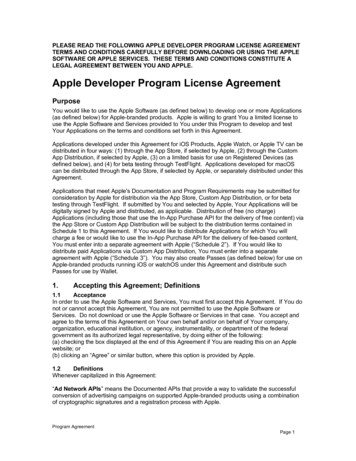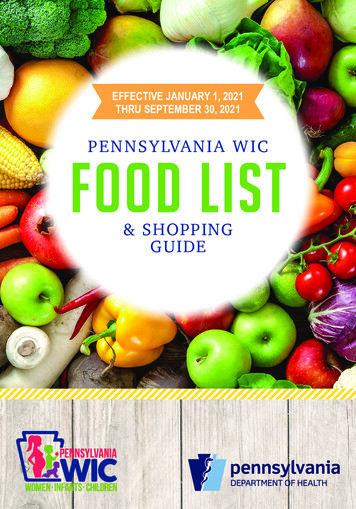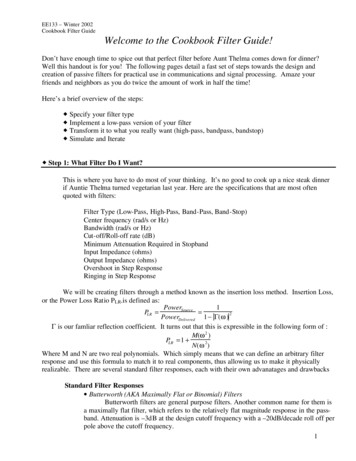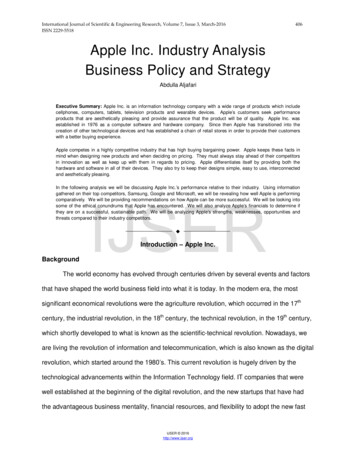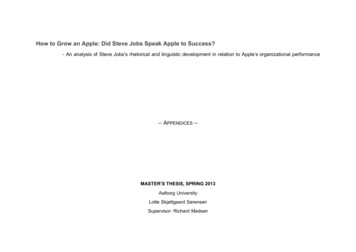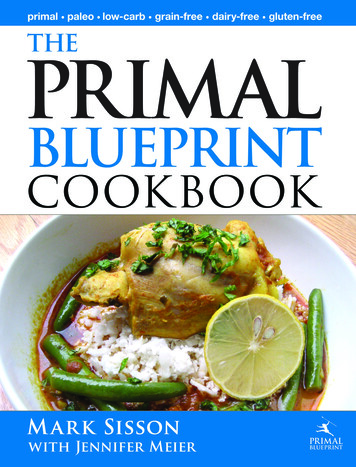
Transcription
THEPRIMALBLuEPRINTCookbookMark Sissonwith Jennifer Meier
The Primal Blueprint Cookbook 2010, Mark Sisson. All rights reserved.Except as permitted under the United States Copyright Act of 1976, reproduction or utilization of this work in any form or by any electronic, mechanical, or other means, now known orhereafter invented, including xerography, photocopying, and recording, and in any informationstorage and retrieval system, is forbidden without written permission of Mark Sisson.Library of Congress Control Number: 2010924523Library of Congress Cataloging-in-Publication DataSisson, Mark, 1953–The Primal Blueprint Cookbook / Mark Sisson with Jennifer MeierISBN 978-0-9822077-2-71. Cooking 2. Health 3. Diet 4. Low CarbEditor/Project Manager: Aaron FoxDesign/Layout:Kristin RoybalConsultants:Anna Salvesen, Jennifer Zotalis, Bradford Hodgson, Reagan SmithFor more information about the Primal Blueprint, please visit www.primalblueprint.comFor information on quantity discounts, please call 888-774-6259Publisher: Primal Nutrition, Inc.23805 Stuart Ranch Rd. Suite 145Malibu, CA 90265
AcknowledgmentsFirst of all, this book couldn’t have assumed its present form withoutvaluable input from tens of thousands of regular readers at my blog,MarksDailyApple.com. The insights and direction from this vibrant community guide my Primal explorations on a daily basis.My co-author Jennifer Meier worked tirelessly to not only bring rich flavor and life to these menu ideas, but she took every single photographin the book. Maybe her kitchen will stay clean for at least a few days ina row now! Aaron Fox, my general manager and MarksDailyApple.comwebmaster, was instrumental in coordinating the efforts of everyoneinvolved in this project, and in editing the Primal Blueprint Cookbook.MarksDailyApple.com staffers Jennifer Zotalis, Bradford Hodgson andReagan Smith offered excellent insights to help improve the text andprovided research and fact-checking support. Gratitude to Anna Salvesen for her early guidance in preparing several of these recipes. Myace designer Kristin Roybal was single-handedly responsible for thefabulous design and layout of both the text and the cover.Special thanks to my wife Carrie and children Devyn and Kyle for allowingme the space to sometimes push the limits of accepted culinary wisdom.i
Table of ContentsIntro.1Sourcing Primal Ingredients.4Stocking The Primal Pantry.6The Primal Kitchen.8Meat Recipes.11Grilled Steak.13Primal Pot Roast.16Slow Cooker Italian Pot Roast.20Shanks a Lot, Bruce.23Cardiff Crack . 26Deli-style Roast Beef .29Bison Chili .32Sausage Stew.36Grandma’s Easy BBQ Pork.39Smoked Sausage and Cabbage.42Transylvanian Stockpot.44Bakin’ Bacon.46Pulled or Chopped Pork Shoulder BBQ.48Roasted Leg of Lamb with Herbs and Garlic.51Five Spice Beef and Broccoli Stir Fry.54Offal Recipes.56Steak and Kidney Stew.57Mild Liver Pâté.60Chopped Liver.62Marrow and Parsley Spread.64Grilled Sweetbreads.66Fowl Recipes.68Coconut Curry.69Easy, Slow-Cooked Chicken and Broth.72ii
Dutch Oven Chicken.76Chicken Soup with Coconut Milk.80Peachy Chicken Salad.82Chicken and Fennel Stew.84Moroccan Chicken.86Roasted Turkey Breast with Herb Butter.88Turkey Kebabs.90Braised Duck with Bok Choy.92Seafood Recipes.96Salmon Chowder.97Fish Broth.100Fish Soup with Coconut Milk.102Stuffed Mackerel.104Nicoise Salad.106Fish Patty Cakes.109Taramasalata.112Whole Fish Baked in Sea Salt.115Shrimp Cakes with Spinach Slaw and Coconut.118Almond DressingChopped Yellowfin Tuna Salad with Avocado and Bacon.120Pan Fried Oysters with Dipping Sauce.122Ceviche.124Steamed Mussels.126Vegetable Recipes.128Eggplant Caponata.129Cream of Greens Soup.132Braised Cabbage.135Bacon Broccoli Salad.138Simple Winter Squash Mash.140Brussels Sprouts with Browned Butter and Hazelnuts.142“Cream” of Broccoli Soup.145iii
Roasted Cauliflower with Lemon Mustard Dressing.148Creamed Kale.150Cucumber Moons with Seaweed Salad.153Egg Recipes.156Eggs Benedict Salad.157Egg Muffins.160Swiss Chard Frittata.162Egg Foo Yung.164Zucchini Egg Bake.166Tomatoes Stuffed with Ground Bison and Eggs.168Almond Crusted Poached Eggs.170Fried Eggs Over Green Chili Burgers.172Hard Boiled Eggs and Salmon Over Cauliflower Rice.174Tamari Eggs.176Primal Substitute Recipes.178Enchiladas.179Mashed Parsnips.182Cauliflower Rice.184Summer Squash Noodles.186Jambalaya.188Spinach Bread.190Nut Crackers.192Coconut Pancakes.194Nut Butter Bars.196Pumpkin Nut Muffins.198Root Vegetable Chips.201Marinades, Sauces and Dressings Recipes.205Mustard and Herb Marinade.206Herb and Caper Marinade.208Sesame Ginger Marinade.210Blackberry Marinade.212iv
Parsley Oil.214Basic Vinaigrette.216Caesar Dressing.218Avocado Mint Dressing.220Coconut Almond Dressing.222Mayonnaise.224Ranch Dressing.228Confetti Dressing.230Lemon Caper Sauce.232Primal 51 Ketchup.234HFCS-free BBQ Sauce.236Pesto.238Dessert Recipes.240Applesauce.241Baked Coconut Milk Custard.244Baked Chocolate Custard.247Peach Clafouti.250Coconut Milk Ice Cream.252Chocolate Truffles.255Walnut Meal Brownies.258Grok Rocks.260Coconut Milk Yogurt.263Beverage Recipes.267Lemongrass Tea.268Refrigerator Tea.270Sage Water.272Spiced Lassi.274Hot Cocoa.276Blackberry Ginger Mocktail.278v
IntroductionPrimal. Paleo. Low-carb. Gluten-free. Dairy-free. Theseare all at least partially descriptive of the latest revolutionin cuisine—a revolution that eschews grains, man madefats and other processed foods in favor of tastier, morenatural fare. It’s also a revolution that promises to letyou enjoy sumptuous feasts of some of nature’s mostsatisfying foods, while allowing you to almost effortlesslylose excess body fat, improve energy levels, get sick lessoften and possibly even live longer.Long ago, our hunter-gatherer ancestors feasted off the land—and sea. Foraging,fishing and hunting for their meals, they evolved to thrive on whatever they could pick,catch or spear. As a result, theirs was a rich and varied diet of plentiful meat, seafood,fowl, fresh vegetables and fruits, and wild nuts and seeds. With this natural bountycame a veritable trove of nutrients: copious antioxidants, polyphenols and minerals,ample protein, nourishing and sustaining fats. These are the nutrients our genes expectfrom us at every meal, the nutrients that ensure that we will be lean, fit, and healthy.Fast forward to 10,000 years ago, and human health in much of the world tooka decisive turn. The advent of the agricultural revolution overturned some 150,000 years of hunter-gatherer sustenance. Grains, the centerpiece of cultivation, nowlargely supplanted the nutrient-rich foraging diet. As archeological evidence reveals,human health and stature took a blow with this nutritional downgrade. Despite thisshift, the evolutionary hunter-gatherer blueprint continued to be passed down througheach generation and, in fact, governs our bodies to this day.More than ever now, we live in an aberrant culinary universe. Our culture’spenchant for sugars, grains (including whole grains) and processed foods constitutesa striking—and costly—incongruity between what our bodies evolved to thrive on andwhat we actually feed them. We see the results in the surging lifestyle diseases thatplague us today: obesity, heart disease, diabetes, arthritis, autoimmune disordersand more.The answer, of course, lies in re-harmonizing our diets with our abidingevolutionary genetic mandate. This is exactly the heart of the Primal Blueprint, a1
constellation of lifestyle principles that seek to realign our daily life with our inherentphysiological design. Informed by the elegant logic of biology, the Primal Blueprintmodel adapts the nutritional cornerstones of hunter-gatherer fare for the culinarytastes and unprecedented variety of the 21st century. I think you’ll find that therecipes in this book represent the gratifying pinnacle of that convergence.In this collection, you’ll enjoy user-friendly recipes for Primal cuisine withincomparable flavor and sumptuousness as well as tips for creating your ownPrimal kitchen. These recipes are part of my own permanent rotation, and theynever disappoint. Many of the selections in this book offer Primal versions of classic,comfortingly familiar dishes. Think succulent Italian pot roast with balsamic vinegarand herbs or rich chocolate custard. Other selections infuse popular ingredients withfresh, original tastes like tender shrimp cakes with coconut almond dressing or friedeggs over zesty green chili burgers.Readers new to Primal eating might notice—but certainly won’t miss—what theserecipes don’t include—specifically the grains that bulk up so many modern dishes.Despite the current love affair with whole grains, the fact remains that they provide fewnutrients and introduce substances like gluten, lectins and phytates that disrupt ourphysiology rather than support it. Their minimal amount of protein, micronutrients andfiber are more efficiently obtained through more nourishing sources like antioxidantrich vegetables and fruits and hearty meats. After all, it really isn’t the grains themselveswe relish in dishes but the savory sauces and meats, the flavorful herbs and veggiesand other “toppings” that we add to them!You’ll also find that another staple of the modern diet, dairy, plays a limited andoptional role in Primal recipes as it did for our hunter-gatherer ancestors. Althoughsome dairy foods like pastured butter and aged cheeses can offer outstanding flavorand richness to Primal dishes, the preponderance of dairy in our modern diet againoften displaces foods to which our genes are perhaps better adapted. The occasionaland intentional use of dairy ingredients like pastured butter and cream in these recipeshighlights their best nutrition and taste; however, non-dairy substitutions offer flavorfulalternatives for those who don’t wish to include dairy.What you will find and truly savor in Primal fare, however, will reward both yoursenses and well-being. Welcome to a whole new eating experience: it’s all aboutfulfillment—and vitality—from here on out!VarietyVariety equals optimum nutrition—and taste. The typical modern diet revolvesaround a depressingly narrow selection of foods more limited than even our parents2
and grandparents enjoyed. The restriction not only diminishes the nutritional valueof our meals, it’s frankly unsatisfying. Primal cuisine restores our ancestors’ culinaryabundance and then some by taking full advantage of a wide-ranging 21st centuryassortment of meats, vegetables, fruits, nuts, seeds and herbs. With the likes ofrosemary and bay-infused roasted lamb, tangy herb and caper marinade, andblackberry ginger mocktails, dinner will never be the same old, same old again.FreshnessThe fresher our food, the more nutritious it is. Freshness was obviously a key benefitto the traditional hunter-gatherer diet. In keeping, Primal eating maximizes nutritionand taste by favoring the freshest, most naturally grown/raised ingredients. Whereverpossible, recipes prioritize pastured, organic seasonal and locally grown/raisedingredients. Imagine cream of greens soup made fresh after a farmers’ market run.Or how about peachy chicken salad on a warm summer evening?RichnessAmong the highlights of Primal fare is the enjoyment of sumptuous, nourishing fats.For those uninitiated in the Primal Blueprint, Primal cooking makes liberal andgratifying use of healthy oils and “clean” animal fats (fats as free as possible fromagricultural contaminants like growth hormones, antibiotics and pesticides). Althoughfrequently and falsely maligned, certain select fats offer key nutrients unavailable inother foods—nutrients critical to the functioning of many physiological systems.Besides all that, many natural fats lend incredible flavor and more satisfaction toeach dish. Envision a chopped yellowfin tuna salad rich with creamy avocado andthick bacon, or braised beef shanks with meat so tender it’s falling off the bone. You’llwonder why you ever ate any other way.Just as the Mark’s Daily Apple blog and my recent book, The Primal Blueprint, sharethe essential principles behind the Primal Blueprint diet, this cookbook serves up someof the best that Primal eating has to offer. The recipes are ideal for Primal Blueprintadherents as well as those following Paleo, Atkins, South Beach, Zone and other lowcarb diets. Although the recipes are based on the Primal Blueprint, they’re great foranyone looking to live a healthier life. If you want more from your eating experience—more flavor, more nutrients, more satisfaction, more vitality throughout your day, thisbook is for you! Whether or not you’re currently a Primal Blueprint follower, I’m confidentthat you’ll savor these dishes as outstanding samples of Primal eating—and enticingevidence that the Primal Blueprint is truly a recipe for thriving. Enjoy!3
Sourcing Primal IngredientsBefore you turn on the stove or light the grill, the first step inmaking a recipe is gathering your ingredients. Keeping yourkitchen well-stocked with a wide variety of fresh, healthyingredients takes effort, there’s no question about that. Butshopping for food doesn’t have to be a chore. It can evenbe fun once you start discovering new ingredients and newways to source them.Use all your senses when you shop—touch and smell produce, let yourself bedrawn towards bright, fresh colors and be curious. Read labels, ask questionsand try things you’ve never tried before. Begin establishing relationships withthe people you buy food from—you’ll be surprised how much you’ll learn.No matter where you live, you probably have more options than you thinkwhen it comes to gathering ingredients. If you can’t find a specific ingredient fora recipe though, don’t sweat it. Use whatever you have on hand or even better,what’s fresh and in season.Grocery StoresFor most of us, whether it’s because of economics or convenience, shoppingat supermarkets is an inevitable part of life. Luckily, you’ll be able to find manyPrimal foods in supermarkets. Supermarkets are a great place to stock up onfrozen and canned foods or items you might want to buy in larger quantities.Specialty markets, co-ops, ethnic markets and online retailers often carrythe harder-to-find ingredients that regular supermarkets don’t. Wherever youshop, just make sure to read the labels so you know exactly what’s in the foodyou’re buying.Farmers’ Markets and Roadside Produce StandsGo directly to the source. These days, most cities hold farmers’ markets atvarious times during the week where you can buy most of your produce andsometimes eggs, meat and fish. A visit to a farmers’ market can even be a socialevent, a way to meet your neighbors and the farmers who supply your food. If4
you have kids, bring them along. Farmers’ markets are kid-friendly and usuallyoffers samples of what’s in season.Community Supported Agriculture (CSA)Have the source come directly to you. Become a “member” of a local farm bybuying a share of their annual yield. Boxes of seasonal produce and in somecases meat, eggs, and dairy products will be delivered (or available for pick-up)on a regular basis and are often less expensive than buying organic producefrom grocery stores.Grow Your OwnWhether you have space for just a few outdoor pots or a large plot of land,growing your own food is something to seriously consider. Almost nothing tastesbetter than a ripe, juicy homegrown tomato plucked from a vine right outsideyour door. More and more people, even city dwellers, are also starting to raisetheir own chickens for eggs. Grow, raise, fish, and hunt your own food and you’llnever have to guess how it was treated and raised.ForagingForaging for wild plants, nuts, and seeds has been key to the survival of thehuman species until fairly recently, when most of us stopped foraging andstarted buying food in stores. Modern-day food foraging is often less aboutsurvival and more about a desire to get closer to our food source and have alittle adventure in the natural world. Some upscale restaurants now hire foragersto find interesting ingredients for the chef. Not all food in the wild, however, isfit to eat so before you bring home some wild greens or mushrooms it’s wise toknow exactly what it is you’re eating. Spend time educating yourself, or betteryet, sign up for a guided walk with an experienced forager.5
Stocking the Primal PantryIn addition to a wide variety of fresh vegetables, meat, seafoodand select fruits that you’ll buy regularly, it’s helpful to have apantry that is well stocked with less perishable staples. Forboth fresh ingredients and non-perishables, buy the mostnatural version you can, avoiding unnecessary ingredients,hormones, antibiotics and pesticides. Buy from localproducers if possible, even for items like honey and nuts.Here are a few key ingredients you’ll want to keep on hand as you cook throughthe recipes in this book:Herbs: Most fresh herbs will keep for up to a week if wrapped loosely in paper towels and stored in an airtight bag or plastic containers with tight lids in therefrigerator. Packed the same way, herbs can also be frozen for several months.Herbs with more delicate leaves, like cilantro and basil, tend to keep best outsideof refrigeration in a jar of water. Herbs can also be dried. Tie them in bunchesby the stem and hang them upside down in a cool, dry place for several weeks.After drying, pull the leaves off the herbs and store in airtight jars.Spices: Most spices are sold in whole and ground form. Ideally, buy whole spicesand grind them right before using—a coffee grinder reserved just for spices workswell for this. Pre-ground spices tend to have less flavor and aromatics than wholespices. Either way, store spices away from heat, light and moisture. Every sixmonths, think about replacing spices with fresh ones.Healthy Fats and Oils: Our bodies need fat, and so do pretty much all recipes ifyou want them to taste good. It’s good to have a few different types of cookingoils for different uses. Nut oils, avocado oil and higher quality (i.e. more expensiveextra virgin olive oils) are best for flavoring food after it’s cooked, rather thanheating the oil up during the cooking process. Less expensive extra virgin oliveoil and butter are good for sautéing and browning food at lower temperatures.Lard, coconut oil, ghee, clarified butter and unprocessed palm oil are good forhigh heat cooking and frying.6
Nuts and Seeds: Staples for our cave-dwelling relations and good to have onhand in modern days, too. Ideally, buy raw nuts and seeds and roast them inyour own oven at low heat if needed. Instead of stocking up on pre-made nutand seed butters, simply make your own by grinding nuts or seeds in a foodprocessor with a little oil.Sea Vegetables: Most forms of sea vegetables (i.e. kelp and seaweed) are driedand will keep in airtight packaging for months.Broths: Consider making your own chicken, beef and vegetable broth andstoring it in the freezer.Non-Dairy Milks: Unsweetened coconut milk is used in many recipes in thiscookbook. This canned milk keeps well for months in a cool pantry.Flour Alternatives: Coconut flour, nut meal or nut flour are all good options.Sweeteners: Although only used in moderation, maple syrup and raw honey aregood to have on hand and keep for months.7
The Primal KitchenThe single best way to improve the quality of yourmeals and ”get Primal” is to choose and prepare foodyourself. In your own Primal Kitchen you are in chargeof the quality of ingredients. Therefore, you determinethe quality of your food, and ultimately the positiveor negative effect on your health and well-being.Cooking at home requires some advance planningand preparation, but is well worth it, especially whenyou have leftovers the next day to pack up for lunch.Here are some tips on how to become a tried andtrue Primal chef.If you are a beginner in the kitchen, start by reading all the way through arecipe before you begin. Don’t be put off by long ingredient lists, as they don’tnecessarily mean a recipe is going to be more difficult. Give yourself enoughtime to cook without feeling rushed. As you gain confidence in the kitchen you’llbe amazed by how quickly you can get a meal on the table. Be prepared forsome things to not turn out as expected and for some recipes to not matchyour palate. The more you cook, the more comfortable you will become withchanging recipes to suit your personal tastes. If you are already comfortablein the kitchen, expand your experiences and try something new: add timelesstechniques to your repertoire, such as preparing bone broths, long cookedroasts or homemade mayonnaise.A well-equipped workspace saves time and effort in the long run, and caneven take much of the drudgery out of meal preparation day after day, year afteryear. Kitchen tools and equipment come in a vast array of options, ranging frombasic and manual to fully automatic with all the bells and whistles. You know thebasics: sharp knives, cutting boards, spatulas, pots and pans, measuring cupsand spoons, etc., but what about the tools and appliances that may not be anecessity? Here are a few of our favorite Primal Kitchen tools that will make lifein the kitchen that much easier.8
Dutch Oven or Casserole: A large, heavy, lidded pot that can be used onthe stove and in the oven and is extremely handy for cooking large roasts orbraising meat.Handheld (stick) Immersion Blender: Blends ingredients right in a pot, bowl orother container. Use it to blend soup, batter, smoothies, etc.Food Processor: For slicing, grating and chopping, as well as some mixingtasks. Some households will manage quite well with only a very small model, buta machine with an 11-cup bowl is the standard size and most convenient.Thermometer (dial or digital): A thermometer takes the guess work out ofcooking meat to desired doneness (rare, medium, well-done).Slow Cooker: Otherwise known as a Crock-Pot, this appliance will slowly andsafely cook meat and vegetables to unbelievable tenderness while you’re busydoing something else.Pressure Cooker: The opposite of a slow cooker. Cooks meat and vegetablesin a fraction of the time it would take with traditional cooking methods. Ideal forcooking soups, stews and large cuts of meat.Mandoline: Slices fruits and vegetables into extremely thin and symmetricalshapes. Great for making zucchini noodles and vegetable chips and for makingsalads more interesting.Dehydrator: Dries fruit and vegetables and can even be used to make jerky.9
Reci
Among the highlights of Primal fare is the enjoyment of sumptuous, nourishing fats. For those uninitiated in the Primal Blueprint, Primal cooking makes liberal and gratifying use of healthy oils and "clean" animal fats (fats as free as possible from agricultural contaminants like growth hormones, antibiotics and pesticides). Although
